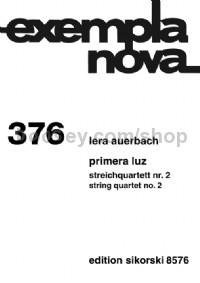Primera Luz (Score & Parts)
Primera Luz (Score & Parts)
* Estimated price converted from UK retail price
"In diesem Werk sind die Grenzen zwischen Weltlichem und Geistlichem unscharf. Sechs Sätze werden zu sechs Gebeten. Der Gebetsakt wird hier nicht in religiöser Weise aufgefasst, sondern als intensive Suche nach der Seele und Blick ins eigene Innere.
Zu beten bedeutet auch, sich gegen die Anforderungen, die täglich an einen gestellt werden, zu verteidigen, den Lärm des Tages zu dämpfen und die Kraft und Zerbrechlichkeit der eigenen Seele zu akzeptieren. Die musikalischen Figuren werden zu Symbolen und die vier Musiker spielen verschiedene Rollen. Der Austausch reicht vom einsamen Monolog über den Dialog eines Duos bis hin zu den unterschiedlichen Persönlichkeiten einer Quartetteinheit als Ganzer.“
Lera Auerbach)
-------------------------------------------
“In this work, the boundaries between the secular and sacred are blurred. Six movements become six prayers. The act of praying here is seen not in a traditional religious manner, but rather as a most intense act of soul searching, a hard and honest look into oneself, questioning and searching for answers. To pray is to relinquish defenses, pretenses, to quiet everyday’s noise, to accept the strength and fragility of one’s own naked soul. Musical gestures become symbols, the four musicians play different roles, from the solitude of a monologue to an understanding of a duo; from the four distinct personalities to the unity of the quartet as a whole. A prayer is a way to connect to one’s own origins, to the distant memories of the primordial light. All the threads lead back to childhood, we are our memories. The First movement is an attempt to find this forgotten melody that is still alive somewhere within – a simple yet longing sound from the past. The Second movement begins with a unsettled viola monologue followed by the cello’s passionate reply, joined later by the violins. The four questions of the Third movement bring back the lonely, fearful, lost sense of the doubtful mind. The Fourth movement is agitated and burning with hopeful fervor of the viola’s almost-human voice. The ecstatic duo of the lower strings, accompanied by trembling violins, grows to a climax that results in the tragic intensity of the Fifth movement. The unbearable tension protrudes between the sustained pedal points of the lower strings and the main thematic material in parallel fifths in the violins. At the end of the movement, the ever-questioning viola brings back the memory of the beginning. The Sixth movement is a postlude, which grows from the darkness of a lament to a quiet chorale that brings if not yet peace - a chiaroscuro sense of hope to find the lost harmony of the primordial light.”
Lera Auerbach




